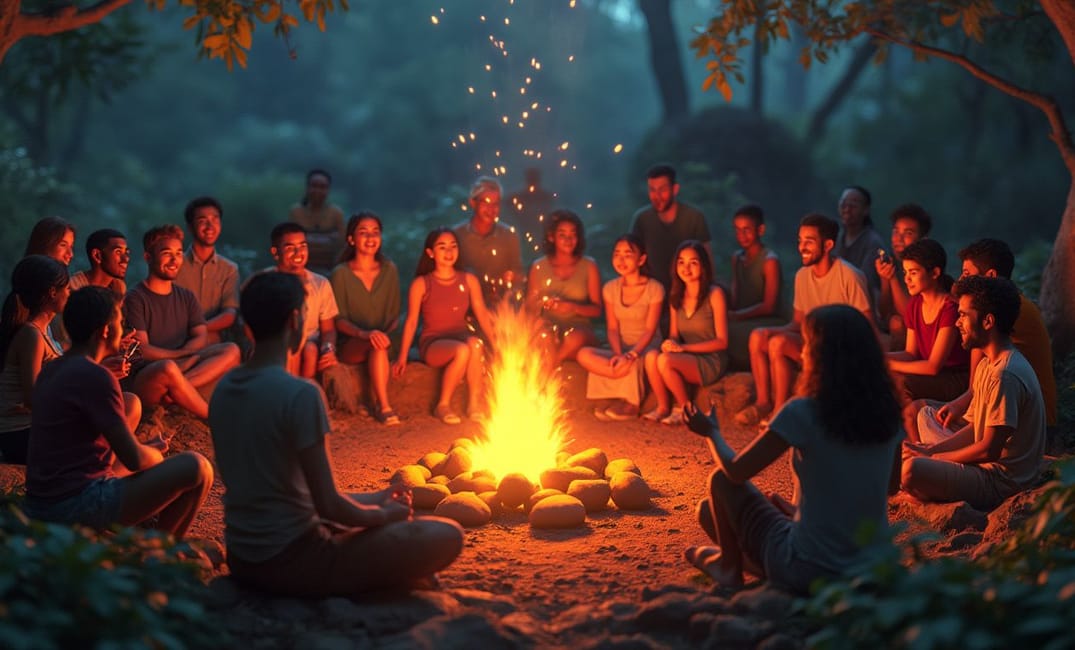Introduction: The Intricate Fabric of Social Rituals
Human interaction is woven intricately into the fabric of societal existence, guiding communal identity and fostering social cohesion. Through traditions and rituals, humanity crafts a shared narrative, infusing meaning into daily life and pivotal milestones alike. Originating from ancient gatherings around fire to contemporary digital interactions, these social practices not only connect individuals but also shape culture, ethics, and values across civilizations. In this entry, we explore the evolution of social practices, examining their roles and transformations as catalysts of collective identity and societal progression.
The Emergence of Early Social Rituals
Prehistoric Gatherings: Kinship and Survival
- Communal Fires and Storytelling: In hunter-gatherer societies, communal gatherings around the fire served as the nucleus of social life. These gatherings facilitated bonding, storytelling, and the exchange of knowledge critical for survival, reinforcing kinship networks and shaping early cultural norms.
- Rituals of Hunting and Harvesting: Celebratory rituals emerged around successful hunts or harvests, blending practical survival with spiritual acknowledgment. Such gatherings were opportunities for reinforcing communal ties, developing cultural identity, and passing ancestral traditions to future generations.
Mystical Practices and Symbolism
- Rites and Ceremonies: Early humans engaged in rituals to navigate the mysteries of the natural world, often invoking supernatural or divine intervention to secure favor or protection. Rituals such as dances, chants, and symbolic gestures were integral to community life, imbuing everyday activities with deeper meaning.
- Totemism and Shamanistic Practices: Totemism and shamanistic practices played vital roles in tribal society, symbolizing the interconnectedness of humans and nature. Shamans, revered as spiritual mediators, employed rituals to heal, protect, and guide communities, fostering a sense of unity and shared destiny.
Ancient Civilizations: Codifying Rituals and Social Structures
Formalization of Traditions
- Religious and Civic Rituals: As societies grew more complex, rituals formalized into religious and civic ceremonies, underpinning social hierarchies. In ancient Egypt, for example, elaborate temple rituals affirmed the divine authority of the pharaoh, reinforcing political structures and religious orthodoxy.
- Rites of Passage and Social Cohesion: Across ancient cultures, rites of passage marked significant life transitions, offering individuals recognition and social acceptance. Rituals surrounding birth, coming-of-age, marriage, and death provided continuity and reinforced collective values and norms.
Festivals and Public Celebrations
- Seasonal and Agricultural Festivals: Festivals such as the Roman Saturnalia or the Indian Holi celebrated seasons and harvest cycles, blending revelry with religious reverence. These events fostered unity, allowing communities to express gratitude, seek renewal, and honor deities collectively.
- Civic Celebrations and Public Spectacles: Public spectacles, such as those in the Colosseum, demonstrated imperial grandeur while reinforcing hierarchical structures and civic identity. Such spectacles offered entertainment and distraction, aligning community loyalties with political interests.
Medieval to Pre-Modern Era: Evolving Practices Amidst Change
The Role of Religion and Pilgrimage
- Religious Observance and Monastic Life: Medieval European life was steeped in religious observance, with monasteries becoming centers of ritual and learning. Monastic practices emphasized discipline, meditation, and communal living, reflecting religious devotion and influencing broader societal values.
- Pilgrimages and Cultural Exchange: Pilgrimages, such as visits to Mecca or Compostela, epitomized spiritual and exploratory quests, fostering cross-cultural exchanges. These journeys enabled interaction between diverse societies, leading to the transmission of ideas, art, and practices.
Courtly and Chivalric Traditions
- Court Rituals and Pageantry: Courtly traditions emphasized pageantry and ritual as reflections of power and sophistication in aristocratic society. Intricate ceremonies codified elite behavior, perpetuating ideals of honor, loyalty, and romance exemplified by chivalric codes.
- Festivals and Feasts: Medieval feasts and tournaments were integral to social life, offering entertainment while displaying noble prowess and generosity. Such events provided spaces for cultural exchange, alliance building, and reinforcing social hierarchies within the feudal community.
The Enlightenment to Modern Era: Transformation through Innovation
Industrialization and Urban Rituals
- Labor Movements and Collective Action: Industrial labor movements emerged as a new form of social ritual, where protests, strikes, and rallies became expressions of collective identity and demand for rights. These gatherings cultivated unity and prompted societal change in increasingly urbanized settings.
- Carnivals and Public Entertainment: Urbanization saw the evolution of public entertainment and street festivals—like Rio's Carnival—which provided outlets for identity expression and societal critique, where norms were playfully subverted amidst burgeoning cultural diversity.
Social Clubs and Civic Engagement
- Social Associations and Clubs: The Enlightenment spurred the creation of social clubs, where intellectual discourse and civic responsibility were cultivated. These gatherings were platforms for debate, innovation, and political mobilization, reflecting the period's ideals of reason, progress, and community.
- Commemorations and National Celebrations: National celebrations like the Fourth of July or Bastille Day fostered national identity and historical consciousness, blending personal and collective memory into integrative narratives that bridged diverse communities.
Contemporary Practices: Globalization and Digital Rituals
The Interplay of Tradition and Modernity
- Global Festivals and Cultural Hybridity: Globalization fosters cultural hybridization, where traditional rituals merge with global influences—evident in music festivals and cultural expos that transcend national borders and celebrate multicultural identities.
- Digital Rituals and Virtual Communities: The digital age introduces new social rituals—hashed under banners like Live Streaming and Social Media Challenges—shaping online communities and creating virtual spaces where traditional and emerging customs coexist and transform.
Challenges and Opportunities in Social Practice
- Rituals and Social Change: Modern social rituals often spearhead societal challenges—where activist movements and digital campaigns stand as rituals pushing for justice and reform, highlighting how collective societal practices can influence policy and call for equity.
- Technological Impact on Traditions: Technology both preserves and alters cultural rituals, providing platforms for cultural preservation, while potentially eroding traditional face-to-face interactions. This dual impact prompts ongoing dialogues about tradition's role amidst technological advancement.
Conclusion: The Continuity of Social Rituals in Human Evolution
Through the cyclical renewal of rituals and social practices, humanity preserves its collective heritage while responding creatively to evolving realities. Across epochs, rituals nurture community cohesion, bridge cultures, and affirm identity, underscoring their central role in historical and contemporary contexts. As societies navigate the complexities of globalization and technological change, rituals remain vital conduits of continuity, cultural resilience, and coherence. By valuing and adapting traditions, humanity can sustain the narrative thread that weaves the global tapestry of shared existence.
"Rituals, echoing through time, chart humanity’s cyclical dance across epochs—each practice an alchemical weave of identity, tradition, and transcendence, guiding footsteps through the sacred tapestry of human connection."
"The enduring power of social rituals showcases their role as central conduits for cultural resilience and coherence, bridging history and present." — Author Unknown
SOCIAL RITUALS, HUMAN INTERACTION, CULTURAL EVOLUTION, DIGITAL AGE, TRADITIONS, GLOBALIZATION, COMMUNAL IDENTITY

